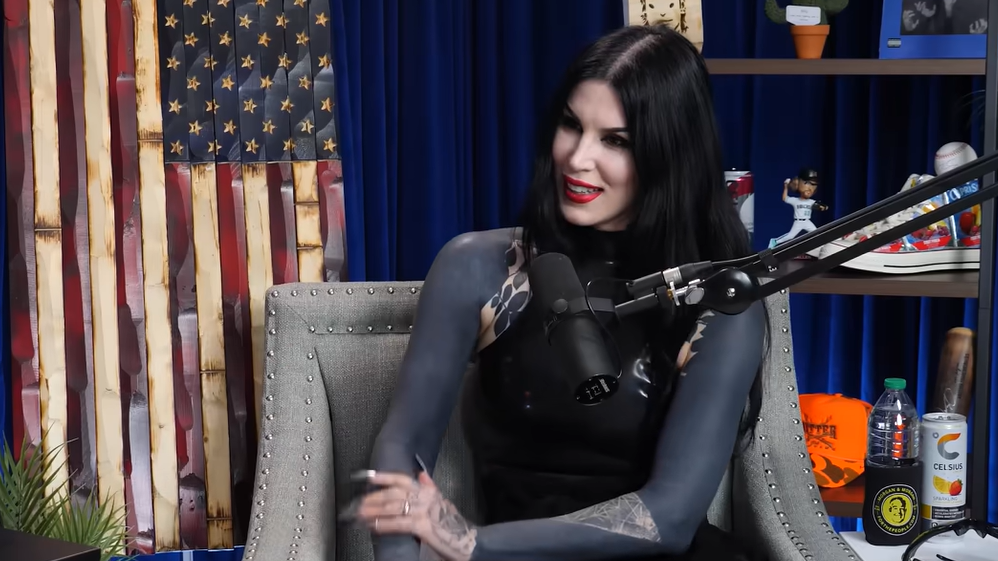Instead of seeing it as the catalyst for a trial that would make headlines, Kat Von D saw her agreement to tattoo a portrait of Miles Davis on a friend’s arm as a sincere gesture. However, that choice ultimately put her at the center of a copyright dispute that was closely monitored by both artists and legal experts.
Photographer Jeffrey Sedlik started the argument by claiming that the tattoo was based on his 1989 portrait of Davis, a powerful black-and-white picture of the jazz great putting a finger to his lips in a silent “shush.” The tattoo and the accompanying social media posts, according to Sedlik, who is well-known for carefully licensing his work, violated his rights.
For Sedlik, protecting the worth of his craft was more important than a single case. He explained how he painstakingly planned the initial photo session, coordinating lighting, posture, and atmosphere to produce the iconic picture. His revenue stream eventually included licensing that portrait, even to tattoo artists. He didn’t think it was appropriate to forego that license.
Von D, on the other hand, maintained that the tattoo was her own creation, made as a private present, and never sold. She emphasized that the work was a form of homage rather than theft, that no profit was made, and that no mass production occurred. She referred to it as “fan art”—an homage that was modified for skin rather than a camera lens and influenced by her aesthetic.
Kat Von D Bio and Career Overview
| Detail | Information |
|---|---|
| Full Name | Katherine Von Drachenberg |
| Professional Name | Kat Von D |
| Born | March 8, 1982, Montemorelos, Mexico |
| Nationality | American |
| Occupation | Tattoo Artist, Entrepreneur, Musician |
| Known For | “LA Ink”, “Miami Ink”, Kat Von D Beauty |
| Tattoo Shop | High Voltage Tattoo (Hollywood, California) |
| Major Lawsuit | Copyright case over Miles Davis tattoo (Jeffrey Sedlik v. Kat Von D) |
| Verdict | Found not guilty of copyright infringement (2024) |
| Official Website | www.katvond.com |

After just over two hours of deliberation, the Los Angeles jury decided to fully support Von D. They decided that fair use protected the tattoo, the initial sketch, and even the social media posts that showed how it was made. Her legal team’s outcome was remarkably successful, and many tattoo artists were relieved because they were afraid that a different decision might have required licensing fees for innumerable reference photos.
The absence of commercial gain was important, her lawyer stressed. The jury determined that the use was sufficiently transformative to prevent infringement, despite Sedlik’s attorney’s contention that the posts served as advertising for her studio. The ruling emphasized that fair use is still a very contextual defense, particularly when an artwork changes its audience, medium, or purpose.
For Von D, the trial was an emotional burden in addition to a legal one. She acknowledged that the experience “crushed” her love of tattooing and implied that, aside from the friend who got the Miles Davis piece, she might never get inked again. The tattoo was particularly significant because Davis’s music held a special place in the heart of that friend, lighting technician Blake Farmer.
Meanwhile, Sedlik cautioned that the decision might weaken photographer protections. He maintained that other artists might have their creations used without their consent if such works are not considered to be “substantially similar.” In order to ensure that the case may go to trial again, his legal team declared their intention to appeal.
This dispute is especially important because it affects more than just tattoo parlors. Similar discussions are taking place in digital art, fashion design, and even music sampling. Given the permanent and intimate nature of tattoos, the Kat Von D case brought attention to the long-standing conflict between preserving original work and permitting artistic reinterpretation.
The trial also highlighted the disparities in perspectives on inspiration among various creative communities. Referencing photos is a common practice in the tattoo industry, where artists alter the composition, shading, and personal style of the images. However, the image itself is the art in photography, and stealing without permission can seem like stealing the essence of the piece.
Although von D’s legal victory may give artists the confidence to stand up for their revolutionary work, it also serves as a warning to proceed with caution. Even in cases where fair use is applicable, establishing it can be expensive, time-consuming, and emotionally taxing. Nevertheless, her triumph offered a positive illustration of how judges can strike a balance between acknowledging fresh creative expression and respecting original works of art.
This conflict between the past and present is reflected in her own journey over the last few years. She has distanced herself from commercial tattooing, concentrated on her music, and even used solid black ink to cover a large portion of her own body art. Given the intended meaning of permanent tattoos, she explained those changes as a means of moving on from parts of her life that no longer fit with who she is.
The human elements of the case—a friend who loved jazz, a tattoo that was given as a gift, an artist who was fighting for the right to reinterpret, and a photographer who was adamant about defending his work—also made it compelling. It was a clash of artistic identities, professional practices, and personal beliefs in addition to legal arguments.
After the verdict, von D’s relief was evident and sincere. “Worrying about this has been a nightmare for me and my fellow tattoo artists for the past two years,” she told reporters. She went from being a defendant in her own case to an advocate for the larger creative community in that instant.

